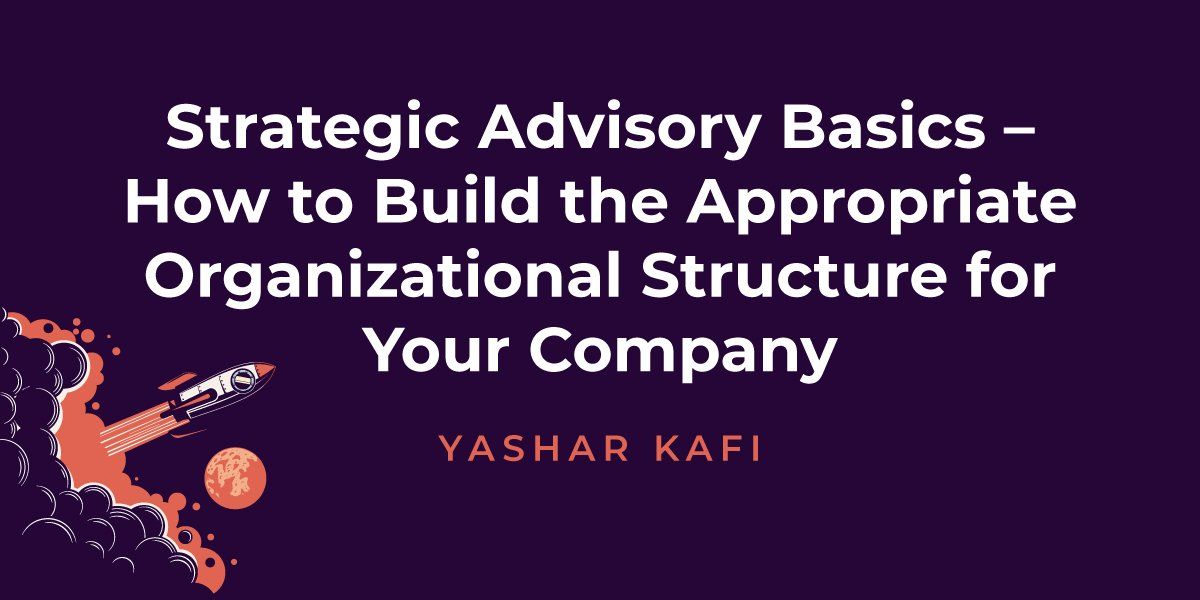How to Build the Appropriate Organizational Structure for Your Company
As companies scale organizational structure and their organizational charts change, understanding different structures and how to use them is crucial. We share our strategic advisory basics to help you build the appropriate organizational structure for your company.
What Is Organizational Structure?
Organizational structure is the structure of a company that shows what employees do, who they report to, and who makes the key decisions for the business. Typically, this is illustrated with a chart commonly called an organizational chart.
On this chart, there should be a clear representation of what everyone does, including the detailed tasks related to their job and who they oversee and report to.
Organizational structure can be set up using markets, products, processes, or even locations.
Hubspot’s description of choosing an organizational structure compares selecting your optimal structure to buying a new car. While there are many excellent options on the market today, only you know your must-haves to choose the style that will put you in the driver’s seat of your company’s success. Regardless of which style your choose, one of your first orders of business should always be setting up a transparent and carefully selected chain of command.
Strategic Advisory 101 — Setting Up Chain of Command
Having a clear, concise chain of command is more important than companies realize. Your team needs to feel secure about who they go to for approvals, office discrepancies, client issues, time off, everything.
Many companies make the mistake of having unclear chains of command. It is vital that you have set answers and protocol. Ask these questions: How many steps does your stepladder need to get to the top? What tasks and approvals belong to each step?
The next step is planning which departments have a say in which decisions. Once that chain of command is decided, the real work begins, and you can build your organizational structure from there.
Organic Organizational Structure
There are several types of structures. An organic organizational structure is less formal and more prevalent in startups and small businesses. This is because it tends to be a little looser and can be customized as the business grows.
Because it’s less stringent and more flexible, it’s also common for employees to “wear multiple hats” and cover various roles beyond their standard scope. This can pose a problem as the business scales, as it can get difficult to shift people around and know who is responsible for what.
For example, typically, scaling means roles grow, so something that was part-time shifts into full-time hours. When this happens, the person responsible for more than one role will have to shift into one. This can create staff difficulties if people are used to doing many things, but it is more flexible.
Mechanistic Organizational Structure
This is an organizational structure that has one central authority, divisions between departments, and specialized roles that work independently of each other. Common examples of mechanistic structures include healthcare, universities, and government organizations.
When most people hear mechanistic organizational structure, they immediately think of narrow spans of control, red tape, and bureaucracy. You might be among them, believing that you wouldn’t opt for this type of structure. However, these teams are surprisingly easier to measure and excel in efficiency.
According to Cerritos College research, “The main advantage of a mechanistic structure is its efficiency. Therefore, in organizations that are trying to maximize efficiency and minimize costs, mechanistic structures provide advantages.”
Strategic Advisory and Organizational Structure
Above are the two basic types of structure, but they can be broken down into even more specific classifications, including:
- Functional: This structure groups employees into functional areas based on their skills and expertise—most areas correspond to niches like operations, research and development, marketing and sales, etc.
- Product-based: Businesses that feature diverse product lines tend to opt for this structure based on the product or service the company provides.
- Geographical: For companies that span several geographic regions, calling for the product or service to be localized by region is required.
- Process-based: HEFLO explained this best, defining it as “A process-oriented organization relies on this idea: final deliveries to its customers are the result of a sequence of internal processes that need to be well organized.”
- Flat: This is when there are few levels of middle management between leadership and employees, sometimes even none at all. This structure is often seen in small businesses and startups especially.
- Circular: This structure upends the usual hierarchy, where instead of at the top of a straight ladder, high-level employees and leaders are at the center of a circle, with regular staff at the outer rim.
All of this can get confusing, and this is where strategic advisory comes in. Strategic advisory basics may cover organizational charts, but scaling businesses requires more advanced knowledge. After all, making a mistake in organizational structure has longstanding impacts, so it’s best to get an expert to help.
Another benefit of recruiting experts, specifically consultants, is that they have seen all kinds of organizational structures for different businesses, including failed ones. And knowing how to avoid those same pitfalls is crucial.
If you want to learn more about how a consultant can help you reach your goals, connect with the team at AMP today.




